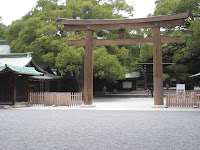After the beautiful sight-seeing day yesterday, the weather turned cloudy and blustery this morning, portending a storm. (This was the morning of the FedEx airplane crash, fatal to the two pilots, where wind shear might have been a factor).

 Machiko added a Tokyo attraction not listed in the itinerary, the Meiji Jingu Shrine, located nearby in the Shibuya Ward. This was a Shinto shrine, dedicated to Emperor Meiji, who died in 1912, and Empress Shoken in 1914. This quiet retreat ensconced in a 175-acre botanical forest was completed in 1921, but the World War II Tokyo air raids destroyed it. In 1958, through a public fund raising, the people of Japan completed a faithful reproduction of the shrine and outbuildings, constructed largely of Japanese cedar and copper.
Machiko added a Tokyo attraction not listed in the itinerary, the Meiji Jingu Shrine, located nearby in the Shibuya Ward. This was a Shinto shrine, dedicated to Emperor Meiji, who died in 1912, and Empress Shoken in 1914. This quiet retreat ensconced in a 175-acre botanical forest was completed in 1921, but the World War II Tokyo air raids destroyed it. In 1958, through a public fund raising, the people of Japan completed a faithful reproduction of the shrine and outbuildings, constructed largely of Japanese cedar and copper.  We had a good time photographing a wedding party on the grounds.
We had a good time photographing a wedding party on the grounds.  Note the couple at the water dipping fount; we saw many people throughout the country wearing face masks, apparently for hygienic reasons.
Note the couple at the water dipping fount; we saw many people throughout the country wearing face masks, apparently for hygienic reasons.We took off for the drive to the mountains. The itinerary called for a view of Mount Fuji from the 5th station (about 7,562 feet altitude), but the inclement weather closed in, so we stopped instead at the Fuji Visitor Center. We were able to take in a video (in English) about Mt. Fuji and environs, then we took off in a rain-snow mix to our luncheon spot.
The restaurant was a French bistro that served an excellent set menu of roast pork with a reduced wine sauce, fresh rolls with no butter in the French style, and a sinfully rich dark chocolate brownie for dessert. We were surprised how Japan has taken to French cuisine; we saw restaurants, boulangeries and patisseries in every city we visited!
Thus sated, we continued to Gora, Hakone, an onsen (hot baths) spa resort town, where we checked in at the Gora Asahi Hotel. This is the one example of a ryokan (Japanese-style) hotel) we encountered on the trip.
 The place was
The place was  fully traditionally Japanese in that we took afternoon tea on cushions in our room over a floor-hugging table. A high-tech teapot was on standby, bubbling away in a corner of our room. We were asked to remove our shoes and walk on the wooden floors in the provided slippers and delicate tatami (reed) mats in our stocking feet. The hotel encouraged us to wear the provided kimonos and tanzen (outer robes) in the public areas.
fully traditionally Japanese in that we took afternoon tea on cushions in our room over a floor-hugging table. A high-tech teapot was on standby, bubbling away in a corner of our room. We were asked to remove our shoes and walk on the wooden floors in the provided slippers and delicate tatami (reed) mats in our stocking feet. The hotel encouraged us to wear the provided kimonos and tanzen (outer robes) in the public areas. We spent the rainy afternoon learning some basic origami and watching a kabuki theater production on the hotel’s wide screen TV.
We spent the rainy afternoon learning some basic origami and watching a kabuki theater production on the hotel’s wide screen TV. We enjoyed a lavish
We enjoyed a lavish  Japanese banquet for dinner with seven appetizers and seven courses! Highlights included the appetizer array of raw sliver salmon, shrimp, smelt and whitefish with assorted vegetables and roe; sukiyaki prepared in wax parchment over a tea candle burner; and a long dish dessert of strawberry and flan with a dollop of whipped cream. Everyone was in awe of the quality and quantity of food on this trip so far!
Japanese banquet for dinner with seven appetizers and seven courses! Highlights included the appetizer array of raw sliver salmon, shrimp, smelt and whitefish with assorted vegetables and roe; sukiyaki prepared in wax parchment over a tea candle burner; and a long dish dessert of strawberry and flan with a dollop of whipped cream. Everyone was in awe of the quality and quantity of food on this trip so far! 
Marie starred as the model for a demonstration of the proper preparation of a traditional kimono for wearing. The attendant, Akiko, spent considerable time tying and retying the obi (sash) around Marie’s waist. The cost of an obi can be more that that of the kimono itself! (Photo Credits: Ray)


While we were dining, hotel staff rearranged our room by moving the table aside, and bringing in futons for us to sleep on. We were skeptical about our sleeping comfort, but it turned out we both slept very well!
No comments:
Post a Comment